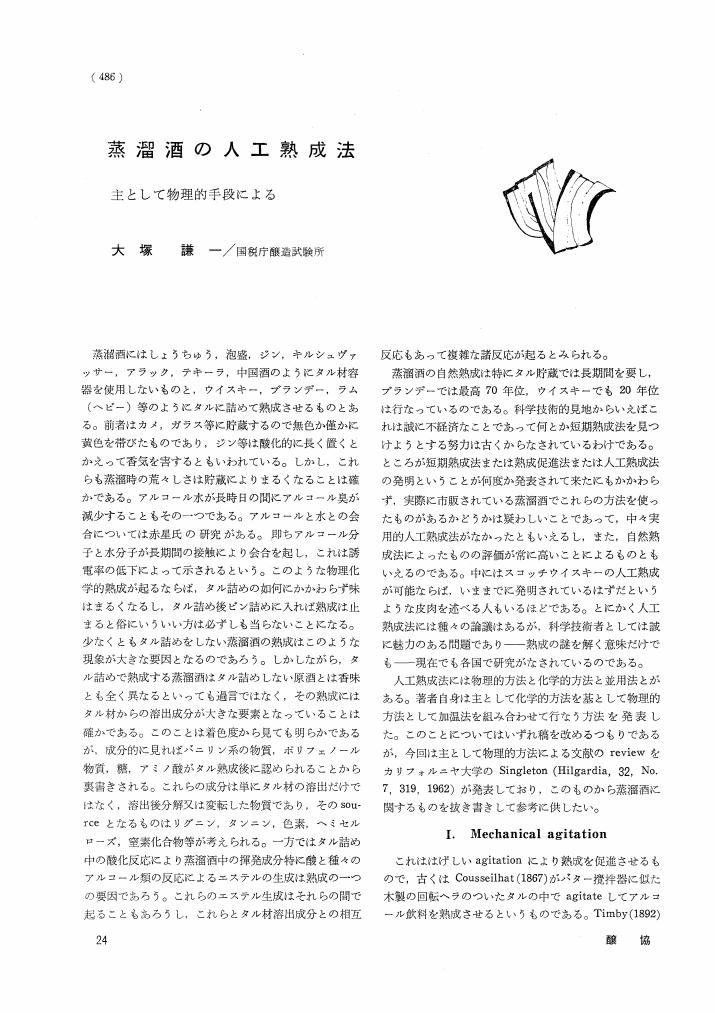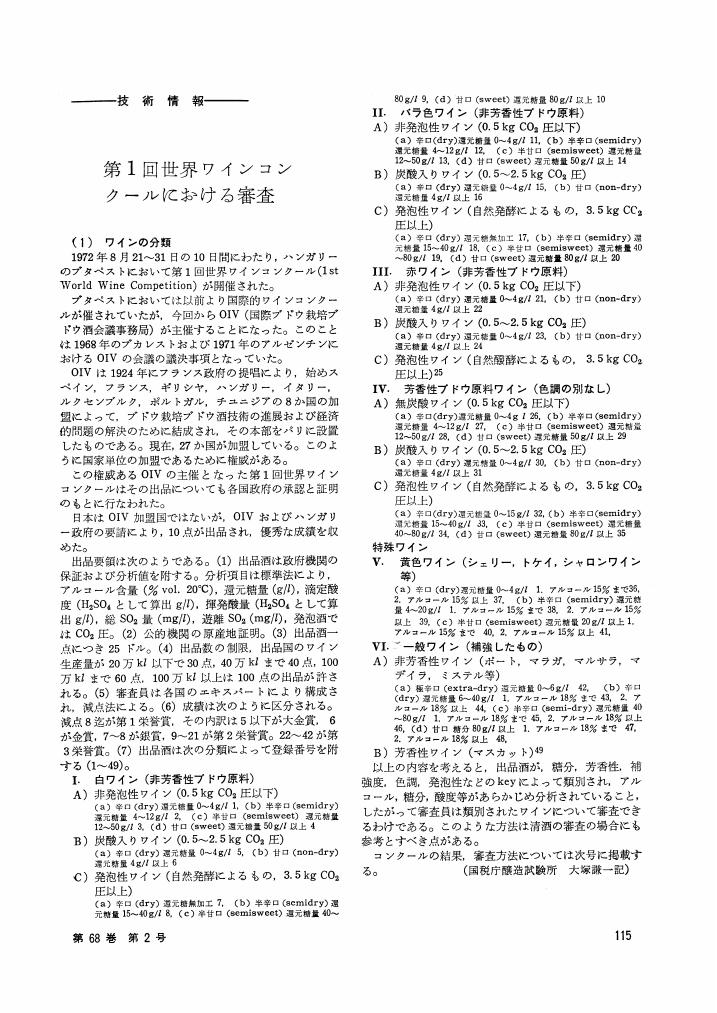3 0 0 0 OA 醸造物の熟成と調熟
- 著者
- 大塚 謙一
- 出版者
- 公益財団法人 日本醸造協会
- 雑誌
- 日本釀造協會雜誌 (ISSN:0369416X)
- 巻号頁・発行日
- vol.69, no.2, pp.83-86, 1974-02-15 (Released:2011-11-04)
熟成の問題は醸造物にとって, その付加価値を高める常に最も重大な手法であり, 多様化の時代に入り, 益々その重要性が高まりつつある。本年はこの問題について一連の解説を予定しているが, まずこの方面の権威である大塚博士に御執筆をお願いした。熟成と調熟を明確に区別すべきだなど, ユニークな提案が盛リ込まれている。
3 0 0 0 OA 蒸溜酒の人工熟成法 主として物理的手段による
- 著者
- 大塚 謙一
- 出版者
- 公益財団法人 日本醸造協会
- 雑誌
- 日本釀造協會雜誌 (ISSN:0369416X)
- 巻号頁・発行日
- vol.60, no.6, pp.486-489, 1965 (Released:2011-12-12)
2 0 0 0 OA 化学成分によるワインの類別 ワインにおける化学成分の意義 (第2報)
- 著者
- 清水 理通 青柳 尚徳 柴崎 茂郎 井上 浩 大塚 謙一
- 出版者
- 公益財団法人 日本醸造協会
- 雑誌
- 日本釀造協會雜誌 (ISSN:0369416X)
- 巻号頁・発行日
- vol.81, no.2, pp.113-120, 1986-02-15 (Released:2011-11-04)
- 参考文献数
- 24
- 被引用文献数
- 2
1. 市販国産白ワイン46点およびフランス産白ワイン24点の計70点と国産赤ワイン33点およびフランス産赤ワイン23点の計56点のワインを25の項目について分析し, その結果について主成分分析を行った。2. 白ワインでは抽出した8つの主成分の累積寄与率は81.7%であった。赤ワインでは6つの主成分が抽出され累積寄与率は80.4%であった。3. 第1主成分 (果汁成分とMLF) と(第4主成分フェノール成分) で国産白ワインとフランスボルドー産白ワインのグループとブルゴーニュ産白ワインが, また第7主成分 (グリセリン) と第8主成分 (残糖) でフランス産白ワインと国産白ワインが類別された。4. 赤ワインでは第2主成分 (ブドウ品種, 高級アルコール) と第3主成分 (ワインの色) で国産ワイン, ボルドー産ワインおよびブルゴーニュ産ワインが類別された.5. ワインを化学成分により, その産地別に類別することが可能であり, それらの成分はその産地に特有の原料, 醸造法に関係するものであった。
2 0 0 0 IR 駿河湾石花海北堆西斜面の海底地すべり
- 著者
- 大塚 謙一
- 出版者
- 静岡大学地球科学教室
- 雑誌
- 静岡大学地球科学研究報告 (ISSN:03886298)
- 巻号頁・発行日
- no.7, pp.p87-95, 1982-03
1 0 0 0 OA 異種酵母の混合使用による清酒醸造試験
- 著者
- 菅野 信男 永谷 正治 佐藤 信 大塚 謙一
- 出版者
- 公益財団法人 日本醸造協会
- 雑誌
- 日本釀造協會雜誌 (ISSN:0369416X)
- 巻号頁・発行日
- vol.76, no.1, pp.45-49, 1981-01-15 (Released:2011-11-04)
- 参考文献数
- 12
清酒の品質の個性化を図ることを目的として, 異種酵母の混合発酵による醸造を行った。混合に際しては, 協会7号と清酒酵母とは異なる他属種の酵母8株を使用した。小仕込醸造試験を行い, 製成した清酒の成分の分析および官能検査から, S. roseiとT. collionlosaを選択した。それらの株につき更に仕込試験を行い検討した結果, s. roseiとの混合発酵の場合に味の軽い良品質の清酒が得られた。なお混用に際しては酵母仕込で行う方が酒母仕込より効果を上げることができると推察された。
1 0 0 0 IR 半田さんをおくる
- 著者
- 大塚 謙一
- 出版者
- 静岡大学地球科学教室
- 雑誌
- 静岡大学地球科学研究報告 (ISSN:03886298)
- 巻号頁・発行日
- no.18, pp.21-22, 1992-07
1 0 0 0 OA シェリー酒タイプの清酒の製造 シェリー酒酵母の清酒表面における産膜条件の検討
- 著者
- 原 昌道 飯村 穣 浜田 康太郎 大塚 謙一
- 出版者
- 公益財団法人 日本醸造協会
- 雑誌
- 日本釀造協會雜誌 (ISSN:0369416X)
- 巻号頁・発行日
- vol.75, no.12, pp.992-996, 1980-12-15 (Released:2011-11-04)
- 参考文献数
- 12
清酒 (Alc.10.0~14.5%) の表面におけるシェリー酒酵母の産膜の条件を検討したところ, 下記のような条件により清酒においても良好に産膜することがわかった。清酒への栄養分の強化として, ピオチン (2μg/l程度) とそれとの相乗効果を持つパントテン酸 (400μg/l程度) を添加すること, それにpHを3.5付近に調節することが必要であった。また, pHを調節する際に乳酸を用いること, 清酒に不足がちなK+ (250mg/l程度) を添加することも旺盛な皮膜を形成さぜるために有効であった。供試シェリー酒酵母6株とも良好に産膜したが, とりわけSF-1株とTOF-3株の2株は旺盛に産膜し, 生成酒の香味も良好であった。これらはいずれも培養温度15℃で最も良く産膜し, シェリー香も生成した。SF-1株を用いた小仕込試験の生成酒では, アセトアルデヒドの増加 (500~1,000ppm) が著しく, また有機酸の増加とアミノ酸の減少が見られた。
1 0 0 0 OA 第1回世界ワインコンクールにおける審査
- 著者
- 大塚 謙一
- 出版者
- 公益財団法人 日本醸造協会
- 雑誌
- 日本釀造協會雜誌 (ISSN:0369416X)
- 巻号頁・発行日
- vol.68, no.2, pp.115-115, 1973-02-15 (Released:2011-11-04)
- 著者
- 原 昌道 大塚 謙一
- 出版者
- 公益社団法人日本生物工学会
- 雑誌
- 醗酵工學雑誌 (ISSN:03675963)
- 巻号頁・発行日
- vol.45, no.2, pp.137-144, 1967
Using malic adapted bacterial cells, the various conditions that induce malo-lactic fermentatzion (MLF) in grape juice, apple juice and wine sterilized with diethylpyrocarbonate (DEPC), were studied.1. DEPC showed inhibitory action against MLF with malic adapted cells of Leuc. mesenteroides at a concentration higher than 200 ppm.2. The rate of MLF in the grape juice, the grape juice containing 250 ppm of DEPC and wine was more rapid with Leuc. sp. than with other lactic acid bacteria strains.3. SO_2 extremely inhibited MLF as shown in a previous paper, but the inhibition was not influenced with DEPC.4. Yeasts in grape juice or wine under SO_2-free conditions were killed completely at above 70ppm of DEPC, but DEPC had no effect on the prevention of browning of grape and apple juice or wine.5. MLF and microbicidal action of DEPC were not influenced by sodium erithorbate (antioxidant).6. From the above results, the appropriate methods of wine and cider making using malic adapted cells are suggested as follows.a) To grape juice or apple juce containing sodium erithorbate (SO_2-free), DEPC (about 200 ppm) should be added to kill microorganism in juice. After an hour, the washed malic-adapted cells (about 10^7/ml) should be added to the juice. This should be kept at 10℃ and allowed to undergo MLF without occuring alcohol fermentation with wild type yeast. When malic acid is decomposed completely, SO_2 (100 ppm) should be added to the grape or apple must and the starter (pure culture of wine yeast, OC No. 2) inoculated. And then this must should be allowed to undergo alcoholic fermentation with the purely cultured yeast at 15℃.b) To wine or cider containing a small amount of SO_2 (20 ppm or less) should be added sodiume erithorbate (about 200 ppm) and DEPC (about 150 ppm). After an hour, the washed malic adapted cells should be added to the DEPC treated wine or cider. Incubations should be carried out at 15℃ for 4〜7 days, and then add SO_2 (about 100 ppm) after complete decomposition of malic acid in order to store safely the resultant wine or cider for long periods.


